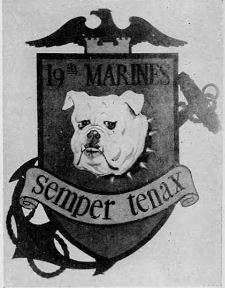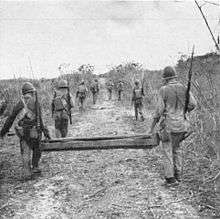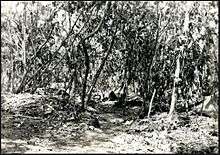19th Marine Regiment (United States)
| 19th Marine Regiment | |
|---|---|
 [1] [1] | |
| Active | 16 September 1942-7 September 1944 |
| Country | United States |
| Allegiance | United States |
| Branch | United States Marine Corps |
| Type | Engineer Regiment |
| Part of | 3rd Marine Division |
| Motto(s) |
|
| Engagements |
World War II * Battle of Bougainville * Battle of Guam |


The 19th Marine Regiment was a composite engineer regiment of the United States Marine Corps subordinate to the 3rd Marine Division. It existed from September 1942 until September 1944.[2] Marine engineer regiments were eventually disbanded in favor of independent engineering battalions within the parent Marine divisions.
Subordinate units
The regiment was a composite of three different types of battalions[3] and a headquarters and service company:
- 1st Battalion, 19th Marines, A, B, & C Companies 3rd Engineer Battalion now 3rd Combat Engineer Battalion
- 2nd Battalion, 19th Marines, D, E, & F Companies 3rd Pioneer Battalion now Combat Logistics Regiment 3
- 3rd Battalion, 19th Marines, G, H, & I Companies 25th Naval Construction Battalion[4] now Naval Mobile Construction Battalion 25 or NMCB 25
History
World War II
Assigned to the 3rd Marine Division, on 11 March 1943 Col Robert M. Montaque took command of the Regiment in New Zealand.[5] September 1943 saw the regiment land in the assault on Bougainville.[6] From there it went to Guadalcanal in preparation for the invasion of Guam in July 1944. It landed in the assault on Guam and was inactivated on 17 August. The 25th NCB was returned to the Navy and assigned to the 5th Naval Construction Brigade, remaining on Guam until the war ended.[7]
With the inactivation of the 19th Marine Regiment the 3rd Engineer Battalion and the 3rd Pioneer Battalion were posted directly to the 3rd Marine Division. The 25th Naval Construction Battion was replaced by the 62nd Naval Construction Batttlion which was also posted directly to the Division for the assault of Iwo Jima. The 3rd Pioneers landed on yellow 2 beach on D-plus 3 and remained there until D-plus 6. On D-plus 6 black beach was created and the pioneers moved there as did the 3rd Engineers. The 62nd NCB was made the lead Battalion for getting Motoyama Airfield #1 operational in place of the 133rd NCB which had taken heavy casualties.
Bougainville campaign: - - - - 1 November–15 December 1943
Solomon Islands campaign:- 15 December 1943 – 9 January 1944
Battle of Guam (1944): - - - - - - - - - 21 July–15 August 1944
See also
- History of the United States Marine Corps
- List of United States Marine Corps regiments
- Naval Mobile Construction Battalion 25
- Organization of the United States Marine Corps
- 3rd Marine Division
- 16th Marine Regiment(Engineer)
- 17th Marine Regiment(Engineer)
- 18th Marine Regiment(Engineer)
- 20th Marine Regiment(Engineer)
- Seabees
Notes
- ↑ 25th Naval Construction Battalion history, Seabee Museun, Port Hueneme, CA 93043. p. 12
- ↑ U.S. Marine Corps World War II Order of Battle Fleet Marine Force Ground Units, Rottman p. 220
- ↑ Battle Orders - US Marine Corps Pacific Theater of Operations 1943-44, Gordon L Rottman, Osprey Publishing, p. 13
- ↑ Rottman, Gordon L. (2002). US Marine Corps World War II order of battle : ground and air units in the Pacific War, 1939-1945 (1 ed.). Westport, Connecticut: Greenwood Press. pp. 218–220. ISBN 9780313319068.
- ↑ Marine Operations in the Northern Solomons, Captain Robert C. Chapin, Marine Hiostorical Center, Washington Navy Yard, Washington, D.C. 1997 p. 8
- ↑ Top of the Ladder: U.S. Marines Operations in the Northern Solomons,Capt. John C. Chapin, Marine Corps History Center, Bldg. 58 Washington Navy Yard, Washington D.C. 1997
- ↑ Seabee unit histories
References
- Bibliography
- Rottman, Gordon L. (2002). U.S. Marine Corps World War II Order of Battle - Ground and Air Units in the Pacific War, 1939 - 1945.’’. Greenwood Press. ISBN 0-313-31906-5.

